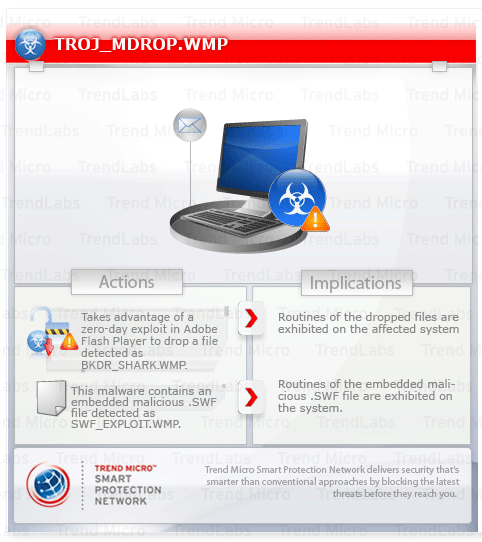TROJ_MDROP.WMP
Windows 2000, Windows XP, Windows Server 2003


Threat Type: Trojan
Destructiveness: No
Encrypted: No
In the wild: Yes
OVERVIEW
This Trojan takes advantage of a zero-day exploit in Adobe Flash Player. Several versions of Adobe Flash Player and Adobe Reader and Acrobat are affected, increasing the chances of malware infection on many computers with the said applications installed.
To get a one-glance comprehensive view of the behavior of this Trojan, refer to the Threat Diagram shown below.

This Trojan drops files detected as BKDR_AGENT.WMP and BKDR_SHARK.WMP. It also contains an embedded .SWF file, which Trend Micro detects as SWF_EXPLOIT.WMP.
This Trojan arrives as attachment to mass-mailed email messages.
TECHNICAL DETAILS
176,144 bytes
DOC
12 Apr 2011
Drops files
Arrival Details
This Trojan arrives as attachment to mass-mailed email messages.
Dropping Routine
This Trojan takes advantage of the following software vulnerabilities to drop malicious files:
- Unspecified vulnerability in Adobe Flash Player, Reader, and Acrobat
NOTES:
Once a Trojan successfully exploits the said vulnerability, it does the following actions on the infected system:
- Drop %User Temp%\{random file name}.tmp - detected as BKDR_SHARK.WMP
- Drop %User Temp%\svchost.exe - detected as BKDR_AGENT.WMP
(Note: %User Temp% is the current user's Temp folder, which is usually C:\Documents and Settings\{user name}\Local Settings\Temp on Windows 2000, XP, and Server 2003.)
Other Details
This Trojan contains an embedded malicious .SWF file that it uses to successfully exploit the aforementioned vulnerability. Trend Micro detects the .SWF file SWF_EXPLOIT.WMP.
It executes the dropped and embedded files. As a result, routines of these malware are exhibited on the infected system.
It also attempts to hide its malicious routines from the user by dropping and opening the non-malicious .DOC file, %User Temp%\AAAA. It deletes and replaces itself with the said .DOC file after executing.
SOLUTION
8.900
7.968.02
12 Apr 2011
7.969.00
13 Apr 2011
Step 1
For Windows XP and Windows Server 2003 users, before doing any scans, please make sure you disable System Restore to allow full scanning of your computer.
Step 2
Remove malware files dropped/downloaded by TROJ_MDROP.WMP
- BKDR_SHARK.WMP
- SWF_EXPLOIT.WMP
- BKDR_AGENT.WMP
Step 3
Search and delete these files
- %User Temp%\AAAA
Step 4
Scan your computer with your Trend Micro product to delete files detected as TROJ_MDROP.WMP. If the detected files have already been cleaned, deleted, or quarantined by your Trend Micro product, no further step is required. You may opt to simply delete the quarantined files. Please check this Knowledge Base page for more information.
NOTES:
For updates on available workarounds and patches for this vulnerability, please refer to the following page:
Did this description help? Tell us how we did.

